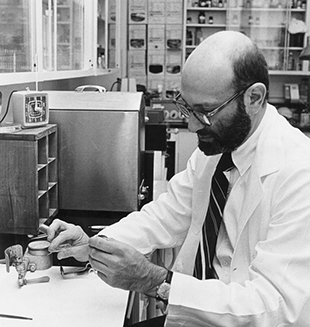

Stanley N. Cohen (1935 )
“Like most scientists, I feel that the opportunity to spend each day doing work
that I love is a great joy.”
–Stanley N. Cohen
National Medal of Science recipient in 1988 “for his discovery of methods for propagating and expressing the hereditary information of DNA introduced into living cells, thereby enabling the cloning of individual genes and the study of their structure and function.”
Stanley N. Cohen, the son of a bookkeeper mother and electrician father, was born in Perth Amboy, N.J. As a teenager, Cohen enjoyed playing and writing American folk music and had one of his songs recorded by an internationally-known vocalist. Cohen decided to keep his musical interests as a hobby, choosing instead to pursue premedical studies at nearby Rutgers University with the encouragement of his father. Cohen received his medical degree from the University of Pennsylvania, where he met his future wife, Joanna Lucy Wolter. While in medical school, Cohen discovered that his interest was in academic medicine, and joined the faculty of Stanford University in 1968 as an assistant professor in the Department of Medicine.
In November 1972, Cohen was in Hawaii presenting a paper at a joint meeting on plasmids, small circles of DNA found especially in bacteria. At the conference, he met Herbert Boyer, who taught just a few miles away from Cohen at the University of California, San Francisco. Cohen and Boyer were conducting similar research and over late-night sandwiches during the conference, they discussed how they might put together a collaborative project investigating the genes that are present on plasmids. Together with Paul Berg, also of Stanford University, Cohen and Boyer conducted the research that ultimately led to the development of genetic engineering. Berg and Boyer are fellow recipients of the National Medal of Science.
Four decades later, Cohen is still at Stanford, continuing his work in genetics and medicine. He remains active with outdoor sports and still enjoys playing the five-string banjo, he says, “when my family can tolerate it.”
Image descriptions and credits
Any opinions, findings, conclusions or recommendations presented in this material are only those of the presenter grantee/researcher, author, or
agency employee; and do not necessarily reflect the views of the National Science Foundation.


